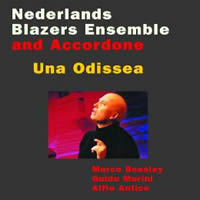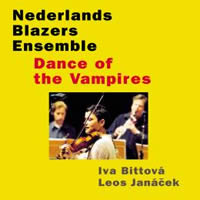Netherlands Winds and Friends
|
Grant Chu Covell [June 2005.] A few months ago, two delicious surprises appeared in my mailbox, both leading to other discoveries. I had never heard the impeccable Netherlands Wind Ensemble, despite their varied Chandos releases (Mozart serenades on CHAN 9284, Beethoven on CHAN 9470, Lang / Adams on CHAN 9363, et al.) and Philips (Strauss’ wind music on 438 733-2 and scads of Mozart repackaged for expectant parents and babies). NBELive is (to use their Dutch name) the Nederlands Blazers Ensemble’s own label, “For those who were there or wished they were there.” The wind band consists of members of the Royal Concertgebouw, the Rotterdam Philharmonic and other Dutch orchestras. The band seeks collaboration with non-classical musicians, presents a famous New Year’s concert, and has released an eclectic, distinctly designed CD series. Iva Bittová and Accordone were also unknown to me despite their many recordings. (Accordone’s website announces an upcoming Cyprès release; Bittová appears on a new Cantaloupe disc.)
Guido MORINI / Marco BEASLEY: Una Odissea. Nederlands Blazers Ensemble; Accordone (Marco Beasley, Guido Morini); Alfio Antico (perc.). NBELive NBECD010 (http://www.nbe.nl/). “Una Odissea might have been performed 400 years ago, on a market square somewhere around the Mediterranean.” Homer’s Odyssey has been refreshed, its story stripped down to mellifluous stanzas about departure, love, return and acceptance. Tenor Beasley — a Cathy Berberian student — wrote the Italian lyrics he sings. His voice is warm and unforced, a pleasure to hear. Infused throughout are Alfio Antico’s frame drums, similar to tambourines. He also contributes some improvisatory numbers and sings in a thick Sicilian dialect. At one point Antico conjures Poseidon’s stormy seas; later Beasley joins in to help dispatch Penelope’s suitors. We’re also treated to stupendous growling in Grammelot, “the language of the wandering troubadours and storytellers of medieval times,” set over a tarantella. I’d ordinarily shun this kind of hodgepodge. Composer / harpsichordist / pianist Morini admits, “When people ask me why I don’t write ‘modern’ music, the only one sensible answer I can think of is: because I can not do it in another way.” A sequence of sinfonias, arias, recitatives and other set-pieces, Morini’s music covers a gamut of styles between Monteverdi and Bach. A Flemish part-song might be followed by something vaguely Corelli-like; elsewhere there are nods to the recitatives from Bach’s passions. However, when Morini takes to the piano, he could be covering for Sarah Brightman. Antico contributes the most folkloric numbers. Purists may be aghast, but the motley works, primarily because it is a joy to listen to the Netherlands Winds and Beasley’s voice. I’ve never heard such poised, balanced and effortless wind playing, from the opening Sinfonia to the virtuoso trumpeting in the aria “Isola….” The most memorable track, “Mi si è adirato,” has a ribald rhythm reminiscent of A Funny Thing Happened on the Way to the Forum. Beasley delivers a remarkably articulated patter song against luminescent winds, including some sprightly 3+3+2+3 measures and a miraculous horn duet. This is the track I’ve been playing for anyone who will listen.
“Dance of the Vampires.” Iva BITTOVÁ / Leos JANÁCEK: Var. songs and arrs. Nederlands Blazers Ensemble; Iva Bittová (voice, violin, viola). NBELive NBECD003 (http://www.nbe.nl/). “Dance of the Vampires” features charismatic Czech vocalist / violinist / violist Iva Bittová performing her own music transcribed for the band (by Stevan Kovacs Tickmayer), along with some airy Janácek arrangements. The collaboration features Bittová’s singing and violin playing. Most anything in Czech allures. The singer’s voice can spring instantly from gravel to silk. Remember the Le Mystère des Voix Bulgares craze? Bittová fiddling is similarly folkloric, with some songs skirting around minimalist chord progressions, such as in “Huljet, huljet,” effortlessly alternating between major and minor. Listen close and you’ll also hear echoes of Bohemia, such as Mahler used in his songs and early symphonies. And then there’s the mystical atmosphere: Bittová harks from the land that produced Kafka, Bruno Schultz and Svankmajer. The hypnotic “A Strange Young Lady” demands repetition. Here and there the crowd erupts joyfully. The Janácek pairing is telling. The arrangements from the piano collection On an Overgrown Path obviously suggest the wind sextet Mládí or the Capriccio for Left-hand Piano and Winds. Bittová makes Janácek sound smooth and pastoral, almost Schubertian. It’s great fun to hear the composer this way, and the Netherlands Winds appear to relish their part. It’s easy to understand why the Bang on a Can troupe recently connected with Bittová to make Elena, CAN21027, where purely instrumental tunes intermingle with Bittová’s warbling. But the collaboration gives off no heat. Bang on a Can doesn’t get to spit and Bittová has been dolled-up. Too bad. Try instead Bittová’s 1997 Nonesuch solo disc (79455-2). The spare, well-recorded eight-song collection hits a nerve, offering “A Strange Young Lady” and “The Vampire’s Ball” in their original form. Some selections involve piano, multi-tracking and a percussionist, but Bittová is clearly the star.
[More Grant Chu Covell]
[Previous Article:
Two Recent Requiems]
[Next Article:
A Requiem Done Right]
|

